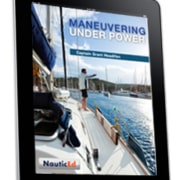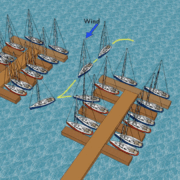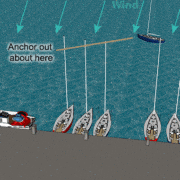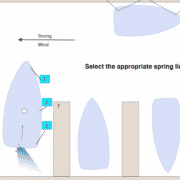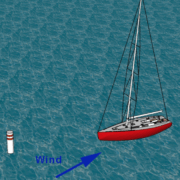We All Make Mistakes
It’s What You Do About Them That Counts
As the Director of Education for NauticEd, the leading sailing education company in the 21st Century, I’ve spent decades on the water, yet I’m far from immune to making mistakes. In fact, my recent experience taught me a valuable lesson about the importance of continuous practice and how virtual reality (VR) can play a crucial role in honing one’s sailing skills.
Let me share a personal anecdote to illustrate this point. Int he real world, I was approaching a marina, and I must admit I was somewhat lackadaisical in my docking approach. I misjudged the wind’s direction and the challenges posed by operating a dual-rudder single-shaft sailboat. It’s worth noting that with dual-rudder boats, you can’t rely on prop wash over the rudders for control. The consequences of my oversight could have been dire as the marina was exceptionally tight. I found myself sideways to the wind, a situation that could quickly spiral out of control.
However, once I got into the pickle situation, I quickly realized my mistake and took corrective action. I turned my boat with the stern facing the wind and then set the boat up appropriately for the wind situation and backed it into the slip, which was the correct maneuver from the start. While I was relieved that the situation didn’t escalate, it served as a powerful reminder of the significance of practice, even for seasoned sailors.
Below, I show my real-world synopsis with some VR-world discussions and recreation of the event.
The lesson here is clear: To excel in sailing, one must remain at the top of their game. My mishap could have been prevented if I had been regularly practicing docking maneuvers in various scenarios and wind conditions – but the problem is this is realistically not practical. Even sailing 3-4 times per month, you just can’t be expected to experience all the docking situations you may encounter at any one time. This is where virtual reality comes into play.
Why Virtual Reality is a Game-Changer for Sailing Success
- Realistic Simulation: VR technology provides a highly realistic sailing environment, allowing sailors to experience various conditions, from calm waters to turbulent seas, all from the safety of dry land.
- Risk-Free Training: In VR, mistakes don’t lead to expensive damages or risky situations. This allows sailors to learn from their errors without any real-world consequences.
- Scenario Diversity: VR offers an array of scenarios that may be challenging to replicate in real life. From crowded harbors to sudden weather changes, virtual reality can prepare sailors for any situation they might encounter on the water.
- Repetition and Mastery: The ability to practice maneuvers repeatedly in VR helps sailors perfect their skills. Repetition is key to mastering any skill, and VR offers a controlled, accessible platform for this.
- Boosting Confidence: Virtual reality can enhance a sailor’s confidence by giving them a chance to tackle challenging situations in a controlled environment before they face them in real life. This confidence can lead to better decision-making under pressure.
- Time and Cost Efficiency: Traditional sailing lessons and practice can be time-consuming and costly. VR training can significantly reduce these expenses while offering more accessible training opportunities.
Sailing and Docking Training in Virtual Reality
Sailing is a dynamic and complex sport that requires a combination of knowledge, skill, and experience. Docking, in particular, can be a nerve-wracking task, especially in tight spaces or adverse weather conditions. Virtual reality is uniquely suited to provide comprehensive training in this aspect of sailing.
Imagine being able to practice docking in a bustling marina with unpredictable winds and currents as often as you like, without ever leaving your home or risking your vessel. VR sailing and docking training can make this a reality.
Why Every Sailor Should Consider VR Training
With the availability of sailing training in virtual reality through NauticEd, there’s no reason for any sailor, whether a novice or an experienced seafarer, to miss out on the advantages it offers. Here’s why you should consider incorporating VR training into your sailing education:
- Safety First: Virtual reality ensures that you’re well-prepared for real-life scenarios, reducing the risk of accidents on the water.
- Skill Enhancement: VR allows you to fine-tune your sailing skills, helping you become a more confident and competent sailor.
- Cost-Effective: Compared to traditional sailing lessons and damage repair costs, VR training is a cost-effective way to maintain your skills.
- Accessibility: VR training is available to anyone with a compatible device, making it accessible to sailors around the world.
In conclusion, we all make mistakes, but the key is to learn from them and strive to improve. Virtual reality provides a powerful tool to enhance your sailing skills, and it’s particularly valuable when it comes to mastering the art of docking. As a sailor, consider embracing this innovative technology to elevate your competence, confidence, and overall enjoyment of the open water. So, what are you going to do about your mistakes? Take advantage of virtual reality training to ensure they don’t happen in the first place. Your future as a successful sailor may depend on it.
The Virtual Reality Docking Course is inside the MarineVerse App on MetaQuest. Go to the NauticEd Virtual Reality Instruction course to gain proper access.
The VR docking course follows the learnings in the NauticEd Maneuvering Under Power course. To maximize your knowledge and training, you should do both courses.

